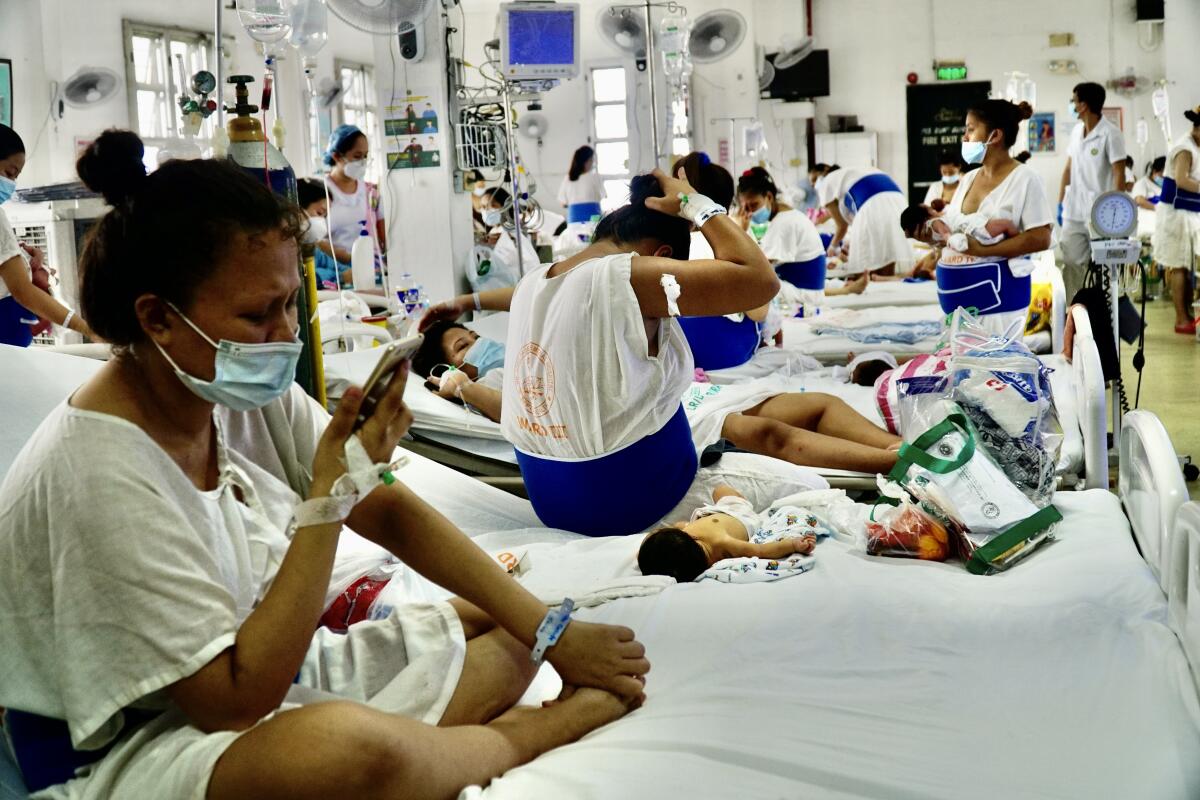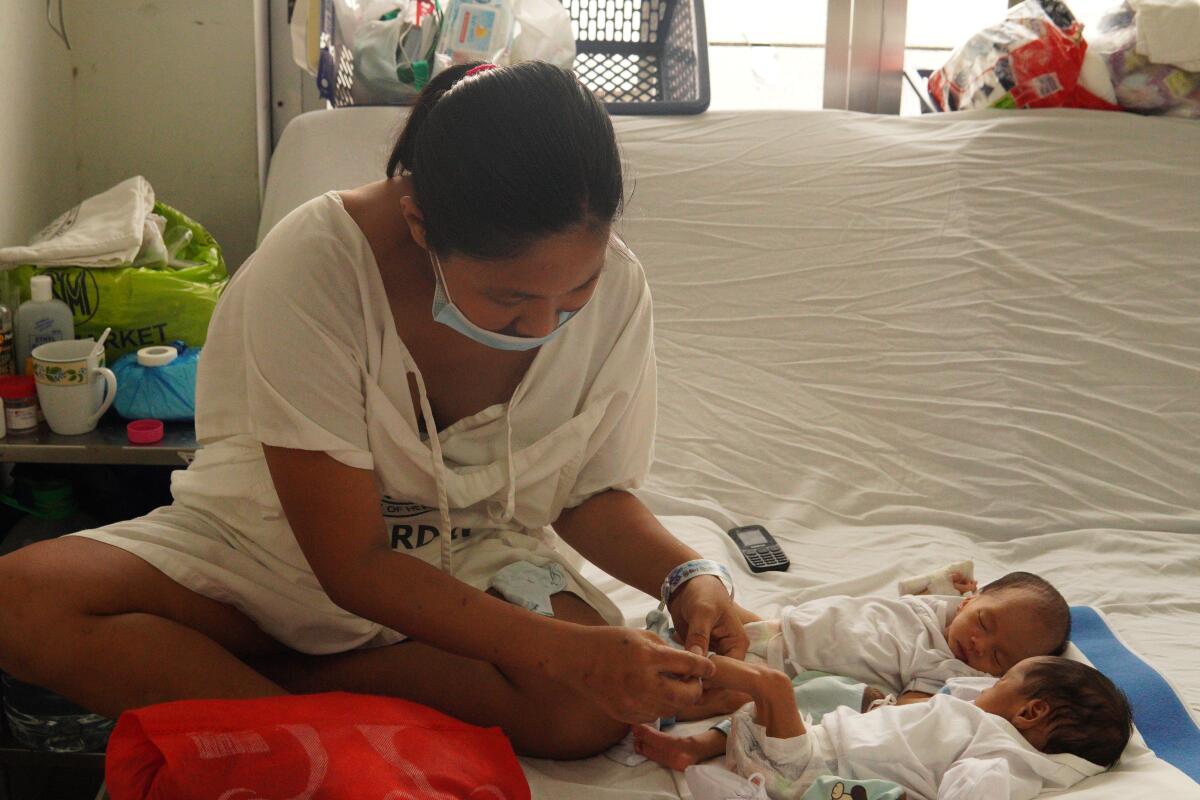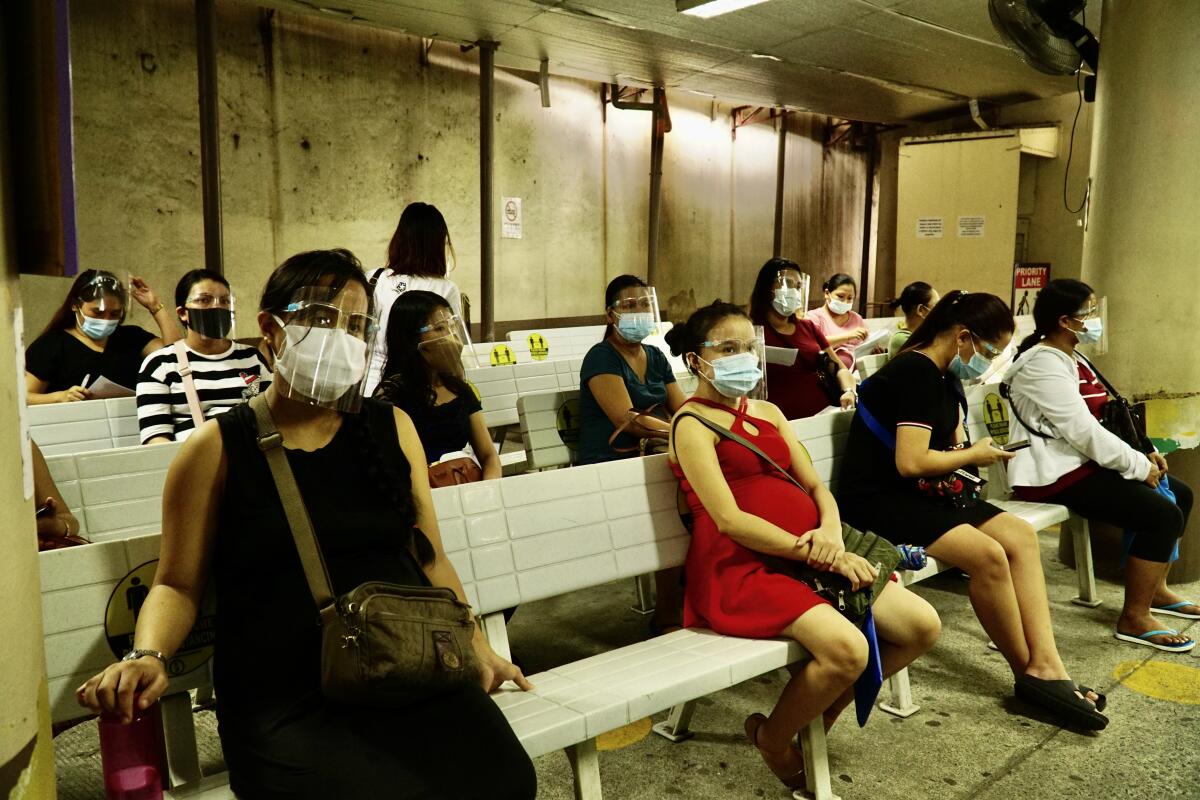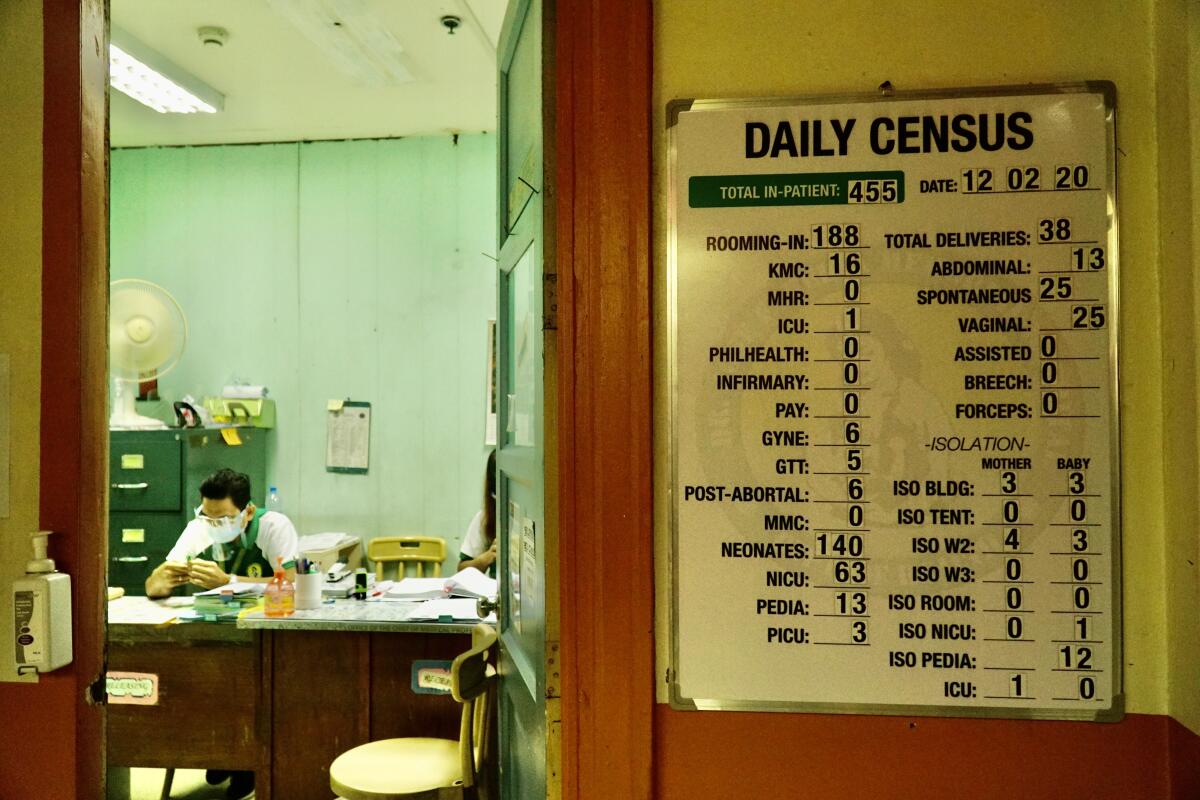The pandemic is fueling a baby boom in the Philippines. For some, that’s bad news

- Share via
MANILA — Rozhiell Fernandez adjusted her mask and attended to her newborn twins lying on a cramped cot inside Dr. Jose Fabella Memorial Hospital’s Ward 4, one of the busiest maternity wards in the world.
Women in faded hospital gowns surrounded her, cradling their babies on beds pressed together in pairs to accommodate up to six nursing mothers at a time. The overcrowding rendered safe distancing impossible and, occasionally, a mother displaying COVID-19 symptoms was wheeled away to an isolation wing.
Fernandez did not want to be at this 100-year-old public hospital, nicknamed the “Baby Factory.” It lies in one of the poorest neighborhoods of the Philippine capital, hemmed in by shanties and the infamous Manila City Jail.
She had hoped to stop having children after her third. But her husband refused to provide legal consent for a tubal ligation, resulting in a fourth child last January and then unexpected twins, who were born prematurely in November.
Her growing family has brought more dread than joy. Fernandez had to quit her job as a call center agent to care for her newborns. Her husband’s courier business was shuttered during a months-long lockdown, leaving the couple penniless and Fernandez without regular medical attention.
“We are struggling to survive in the middle of a pandemic,” said Fernandez, 33, who at first ignored the bump in her stomach from the twins, believing a woman could not get pregnant while breastfeeding.

Hospitals and clinics are girding for more cases like Fernandez’s. After years of modest success slowing high fertility rates that have exacerbated the country’s stifling poverty, the Philippines is expected to face a baby boom at a time when its meager healthcare system is stretched thin by the scale of the coronavirus crisis.
The pandemic and subsequent lockdowns disrupted access to family planning, which researchers at the University of the Philippines Population Institute and the United Nations Population Fund estimate increased unintended pregnancies among females ages 15 to 49 by more than 40% to 2.5 million.
The Philippines’ Commission on Population and Development said the nation of 109.5 million is on pace to record its highest birth rate since 2012, the year a landmark reproductive health law was passed mandating access to family planning in a country where contraception has traditionally been met with opposition, particularly from the powerful Philippine Catholic Church.
Up to 300,000 Philippine fishermen are unable to return to land due to COVID-19 restrictions and could soon be abandoned by bankrupt boat owners.
The study said the surge in births will probably increase maternal deaths and deepen the Philippines’ crisis with teenage pregnancies, which the government labeled a national social emergency in 2019. More children will also lead to overcrowding, hunger and disease among the urban poor.
The Philippines is reeling from the pandemic and is expected to post its largest economic contraction in decades, worsening a poverty rate of 16.6% that’s nearly double that of other large countries in the region including Indonesia and Thailand. The World Bank estimates 2.7 million more Filipinos fell below the poverty line last year, defined as someone living on no more than $3.20 a day.
Women and children now face a “double crisis” bearing the brunt of the economic turmoil and health emergency, said Sen. Risa Hontiveros.
The health and women’s rights advocate said the country’s health system has undergone a “Covid-ization,” which meant budgets for reproductive health programs were diverted to COVID-19, making it harder for women to access birth control during the lockdown.
“The COVID-19 pandemic even made our healthcare system ill,” Hontiveros said. “There was a de-prioritization of the other chronic and also important, long-standing health concerns of Filipinos.”

Getting contraception was a struggle for many Filipinos before the pandemic. Birth control is taboo in a country where 80% of the population identifies as Catholic. In the past, the church has successfully pressured officials to ban contraceptives in public clinics to promote “a culture of life.”
The reproductive health law, envisioned as a cure-all for maternal care, family planning and sex education to slow the nation’s birth rate, was supposed to blunt the church’s resistance. It took a 12-year legislative battle before it passed into law. Then, the measure hurdled another two-year fight at the Supreme Court, where key provisions, including teenage access to contraceptives, were watered-down.
A jailed Philippine activist is forced to attend her infant’s funeral in handcuffs and a hazmat suit
The death of Reina Mae Nasino’s 3-month-old daughter, River, has sparked an uproar over President Rodrigo Duterte’s crackdown on human rights defenders. The underweight infant was separated from her mother, denying her breast milk that could have prolonged her life.
The new law did not significantly curtail births — the population growth rate between 2015 and 2019 declined to 1.52% compared with 1.73% between 2010 and 2015 — but it was encouraging. And while abortion and the morning after pill remain outlawed, condoms and birth control pills are more readily available than ever.
Health experts say it will take years, if not decades, to change the culture.
Caren Pineda, a nurse at Likhaan Center for Women’s Health, a nongovernmental organization promoting the protection of women’s sexual and reproductive rights, said myths about contraceptives persist, leading many women to resist modern family planning methods.
“Social media posts about the inefficacy of [IUD] implants, for example, discourage other women,” Pineda said. “They believe these posts because the claim was they were based on personal experience.”

Jovie Luardo, 21, is a patient at Fabella. She said she refused to take birth control pills because a friend warned her falsely that they could cause ovarian cysts. Luardo and her boyfriend opted for a calendar rhythm method to avoid pregnancy, considered one of the least effective forms of birth control.
Luardo is expecting a child any day. Her prospects, like those of many new mothers around her, are daunting. She faces a future as an unemployed parent with a boyfriend struggling to earn money.
“What if we cannot provide for our child?” Luardo said.
The cream-colored hospital occupies the former administrative building of the Old Bilibid Prison. It doesn’t look like it’s changed since it opened in 1920, when the United States had dominion over the Philippines as a colonial power. It’s a symbol of how little investment has gone into public health over the decades, though President Rodrigo Duterte signed a universal healthcare law last year that provides all Filipinos with subsidized insurance.
The hospital gate is normally a chaotic scene of pregnant women pouring in for checkups or deliveries. But since the pandemic, the crowds have been replaced by tents for screening visitors for COVID-19 symptoms. In October, Fabella briefly shut its doors for the first time in a century after a team of doctors tested positive for the coronavirus.
The number of deliveries at Fabella has decreased to between 40 and 60 a day, about half the number before the reproductive health law was implemented. But the number of patients still exceeds the number of beds.
Doctors acknowledge that resources are under strain. But for many pregnant women, the hospital is a refuge of last resort. During the peak of the pandemic, Fabella was admitting patients and pregnant women rejected by other hospitals that were either overcrowded or closed by coronavirus infections.
“We can’t shoo these mothers away because they will die if no one accepts them,” said Diana Cajipe, a veteran obstetrician-gynecologist at the hospital.
Times staff writer Pierson reported from Singapore and special correspondent Balagtas See from Manila.
More to Read
Sign up for Essential California
The most important California stories and recommendations in your inbox every morning.
You may occasionally receive promotional content from the Los Angeles Times.













